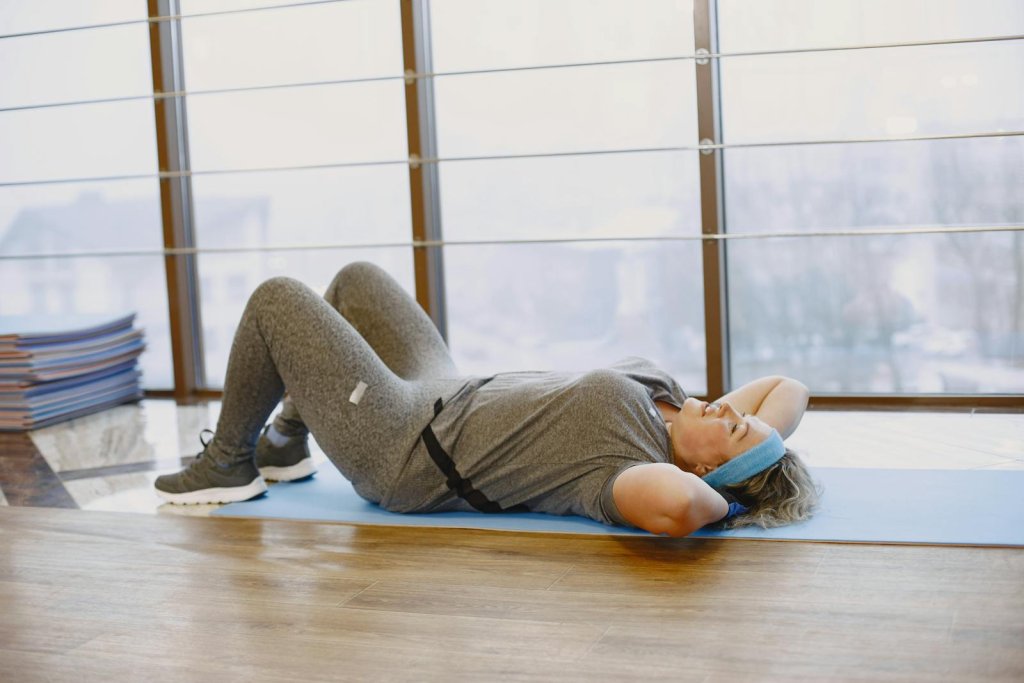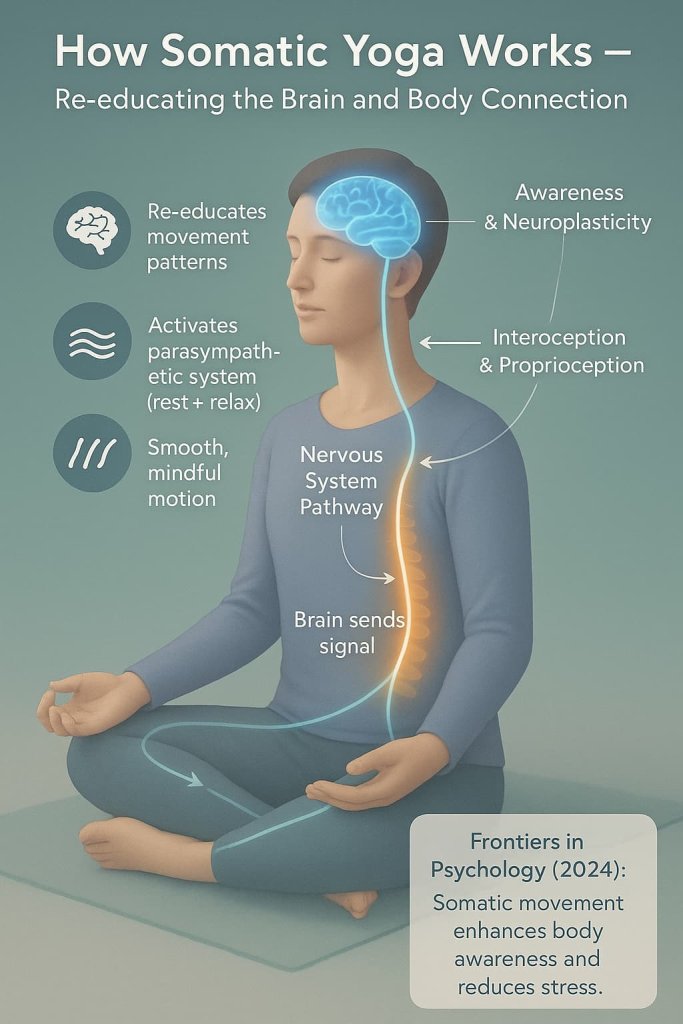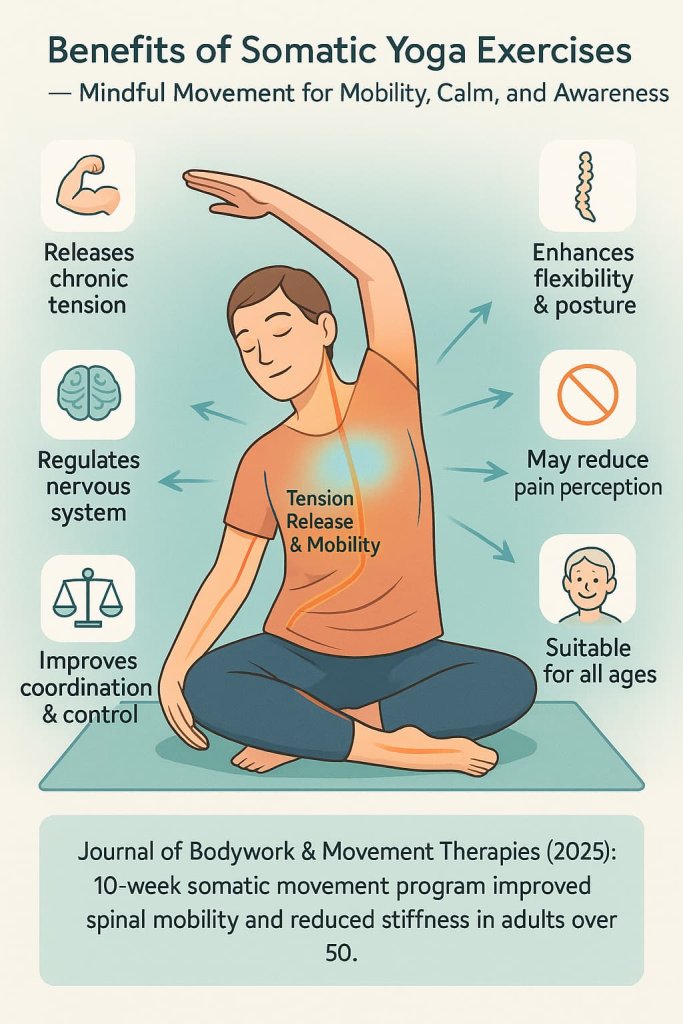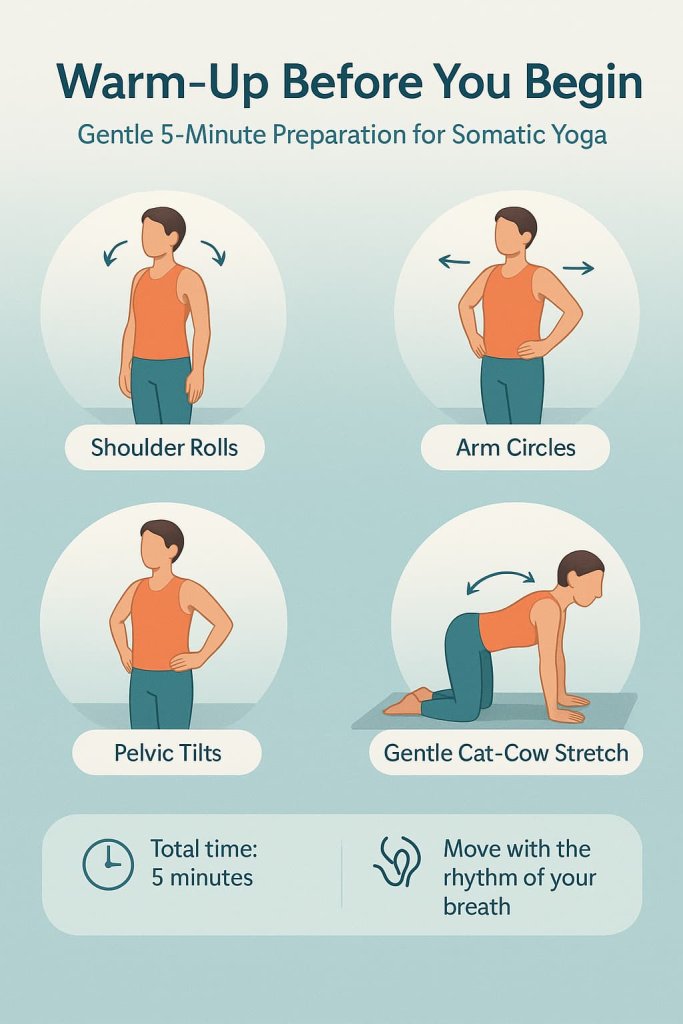Somatic yoga exercises are gentle, mindful movements designed to retrain your nervous system, release chronic muscle tension, and restore body awareness.
Unlike traditional yoga that focuses on holding poses, somatic yoga emphasizes internal sensing—noticing how movement feels from the inside out. This approach helps improve flexibility, reduce stress, and enhance posture through small, deliberate actions.

Understanding somatic yoga is important because it bridges neuroscience and movement: you’re not just stretching muscles—you’re re-educating the brain to move efficiently. Whether you’re dealing with stiffness, stress, or pain, these 12 somatic yoga exercises can help restore natural movement and calm the nervous system.
What Is Somatic Yoga?
Somatic yoga blends traditional yoga postures with the science of somatics—a practice focused on sensory awareness and neuro-muscular re-patterning. The word somatic comes from the Greek soma, meaning “living body.”

Key somatic influences include:
- Feldenkrais Method – Improves coordination and movement efficiency.
- Hanna Somatics – Releases muscle tension through “pandiculation.”
- Alexander Technique – Refines posture and body alignment.
- Body-Mind Centering – Connects breath, sensation, and movement.
Science Insight
A 2024 study in Frontiers in Psychology found that somatic awareness training enhances interoception (the ability to feel internal body signals), leading to better emotional regulation and movement control.
How Somatic Yoga Works
Somatic yoga works by retraining your nervous system to move efficiently and release chronic muscle tension. Instead of forcing stretches, it builds awareness through slow, mindful motion—teaching your brain to recognize and correct movement patterns.

This process improves interoception (internal body sensing), proprioception (spatial awareness), and promotes neuroplasticity, helping restore coordination and posture.
Research in Frontiers in Psychology (2024) shows that somatic movement enhances body awareness and reduces stress by activating the parasympathetic “rest and relax” response.
In short: Somatic yoga re-educates the brain, not just the body—creating balance, ease, and mindful control in every movement.
Benefits of Somatic Yoga Exercises

- Releases chronic muscular tension and restores mobility.
- Improves body awareness and coordination.
- Supports nervous system regulation by calming stress responses.
- Enhances flexibility and posture through slow, mindful motion.
- May reduce pain perception by improving sensory feedback.
- Suitable for all ages, including seniors and beginners.
Research Insight: According to the Journal of Bodywork & Movement Therapies (2025), a 10-week somatic movement program improved spinal mobility and reduced perceived stiffness in adults over 50.
Warm-Up Before You Begin
Spend 5 minutes warming up to activate your muscles and prepare your joints.

Quick Routine:
- Shoulder rolls – 10 forward and back
- Arm circles – 10 each direction
- Pelvic tilts – 10 reps
- Gentle cat-cow stretch – 5–6 slow cycles
- Deep diaphragmatic breathing – 30 seconds
The 12 Best Somatic Yoga Exercises
Each exercise focuses on gentle awareness, breathing, and internal feedback rather than intensity. Move slowly and avoid forcing any range of motion.
1. Somatic Cat-Cow Flow
Why it works:
Re-educates spinal mobility and synchronizes breath with movement. It helps release tension in the back and neck while retraining the nervous system to move the spine fluidly through flexion and extension.
Muscles worked:
Erector spinae, rectus abdominis, obliques, trapezius, rhomboids.
How to do it:
- Begin on hands and knees, wrists under shoulders and knees under hips.
- Inhale, lift your tailbone and chest as your belly drops (Cow).
- Exhale, tuck your chin and round your spine (Cat).
- Move slowly, sensing each vertebra’s motion as if rolling through your spine.
Trainer Tip:
Close your eyes and match movement to your breath rhythm—this deepens awareness and helps identify areas of stiffness or hesitation in the spine.
2. Pandiculation Stretch (Full-Body Release)
Why it works:
Mimics natural yawning or stretching that resets muscle tone and releases chronic tension through “pandiculation,” a controlled contract–release action that reprograms the nervous system.
Muscles worked:
Full-body engagement: deltoids, spinal extensors, glutes, hamstrings, and abdominals.
How to do it:
- Lie down or sit comfortably.
- Gently contract your muscles as if doing a big morning stretch.
- Slowly release the contraction while focusing on the sensation of letting go.
- Breathe deeply throughout.
Trainer Tip:
Imagine “stretching from the inside out” rather than forcing range of motion—this enhances neuromuscular relaxation and awareness.
3. Somatic Bridge Roll
Why it works:
Retrains the sequence of glute and spinal activation while improving pelvic control. It teaches you to articulate the spine one vertebra at a time and relieves lower back tension.
Muscles worked:
Gluteus maximus, hamstrings, spinal erectors, transverse abdominis.
How to do it:
- Lie on your back, knees bent, feet hip-width apart.
- Inhale, gently tilt the pelvis backward, and roll your hips up.
- Lift slowly until shoulders, hips, and knees align.
- Exhale, lower one vertebra at a time back to the mat.
Trainer Tip:
Move as if your spine were a chain lifting and lowering in sequence. Avoid pushing through the feet—let the hips lead the motion.
4. Pelvic Clock
Why it works:
Improves pelvic proprioception, releases lower back tightness, and teaches fine control of pelvic tilt and rotation.
Muscles worked:
Pelvic floor, lower abdominals, gluteus medius, lumbar stabilizers.
How to do it:
- Lie on your back with knees bent.
- Visualize your pelvis as a clock: 12 o’clock near your navel, 6 o’clock near your tailbone.
- Slowly tilt and roll your pelvis around the “clock” positions, tracing a smooth circle.
- Keep breathing evenly.
Trainer Tip:
Use minimal effort—tiny, slow movements increase awareness and coordination far better than large, fast motions.
5. Somatic Side Bend
Why it works:
Lengthens the lateral body, opens tight fascia along the ribs and obliques, and enhances breathing depth.
Muscles worked:
Obliques, latissimus dorsi, intercostals, quadratus lumborum.
How to do it:
- Sit cross-legged or stand tall with arms relaxed.
- Inhale, reach one arm overhead; exhale as you gently bend to the opposite side.
- Feel the stretch expanding from hip to fingertips.
- Repeat on both sides slowly.
Trainer Tip:
Keep both hips grounded—avoid leaning forward or twisting. Focus on opening the rib cage rather than reaching farther.
6. Leg Slide Awareness Drill
Why it works:
Improves coordination between hip flexors and core stabilizers while reducing compensations in the lower back.
Muscles worked:
Iliopsoas, rectus femoris, transverse abdominis, gluteus medius.
How to do it:
- Lie on your back, knees bent.
- Slowly slide one heel along the mat, extending the leg.
- Pause, then return to the starting position.
- Keep your pelvis steady and core gently engaged.
Trainer Tip:
Imagine balancing a glass of water on your lower belly—move smoothly enough that it wouldn’t spill.
7. Somatic Shoulder Rolls
Why it works:
Releases neck and upper-back tension by mobilizing the shoulder girdle and activating stabilizers that improve posture.
Muscles worked:
Trapezius, deltoids, rhomboids, levator scapulae.
How to do it:
- Sit or stand tall with arms relaxed.
- Inhale, lift your shoulders toward your ears, then roll them back and down.
- Reverse direction after 5–8 rolls.
- Coordinate the motion with slow breathing.
Trainer Tip:
Visualize melting stress with every exhale. Avoid jerky or forced movements; smooth motion builds awareness.
8. Constructive Rest Pose (Awareness Practice)
Why it works:
Encourages total-body relaxation and recalibration of postural tone through gravity-assisted release. It’s a reset for your nervous system.
Muscles worked:
Passive relaxation of the whole body, including spinal stabilizers, hip flexors, and shoulders.
How to do it:
- Lie on your back, knees bent, feet flat.
- Place arms comfortably by your sides.
- Close your eyes and observe your breath.
- Notice the weight of your body and points of contact with the floor.
Trainer Tip:
Stay for 3–5 minutes. The goal isn’t to “do” but to notice—each breath helps the body find balance.
9. Somatic Forward Fold (Halfway Lift Flow)
Why it works:
Combines spinal articulation and hamstring lengthening while teaching control through the hinge pattern.
Muscles worked:
Hamstrings, erector spinae, gluteus maximus, core stabilizers.
How to do it:
- Stand tall, feet hip-width apart.
- Exhale to hinge forward from the hips, keeping the spine long.
- Inhale to lift halfway up, extending through the crown of the head.
- Move slowly between the two positions for 6–8 cycles.
Trainer Tip:
Bend your knees slightly if hamstrings feel tight. Focus on elongation, not depth.
10. Somatic Neck Release
Why it works:
Relieves built-up cervical tension and improves small stabilizer activation, helping correct postural strain.
Muscles worked:
Sternocleidomastoid, upper trapezius, levator scapulae, deep neck flexors.

How to do it:
- Sit tall, shoulders relaxed.
- Slowly tilt your head side to side.
- Pause briefly where you feel mild tension, then return to center.
- Breathe evenly throughout.
Trainer Tip:
Think of your head as floating on top of the spine—avoid forcing range or rolling backward, which can compress the neck.
11. Supine Twist Awareness Flow
Why it works:
Improves spinal rotation, massages abdominal organs, and promotes relaxation by engaging the parasympathetic system.
Muscles worked:
Obliques, multifidus, spinal rotators, gluteus medius.
How to do it:
- Lie on your back, arms extended in a T-shape.
- Bend your knees and let them drop gently to one side.
- Inhale to center, exhale to the other side.
- Keep shoulders grounded.
Trainer Tip:
Keep the twist gentle—aim for spinal decompression, not torque. Allow gravity to assist rather than pushing.
12. Somatic Mountain Pose (Tadasana Awareness)
Why it works:
Reinforces balanced posture, grounding, and awareness of muscular engagement throughout the body’s kinetic chain.
Muscles worked:
Quadriceps, gluteus medius, erector spinae, calves, and intrinsic foot muscles.
How to do it:
- Stand tall with feet hip-width apart, arms relaxed by your sides.
- Spread your toes and feel equal pressure through both feet.
- Gently engage your thighs and lengthen your spine upward.
- Breathe slowly and observe subtle shifts in balance.
Trainer Tip:
Close your eyes for a few breaths—notice micro-adjustments as your body stabilizes. This builds powerful postural awareness.
Safety Tips
- Move slowly and without pain—never force range.
- Stay aware of breath and internal sensations.
- If you have chronic pain or a medical condition, consult your healthcare provider first.
- Focus on comfort, not performance.
How Often to Practice
Start with 10–15 minutes daily, gradually increasing to 30 minutes, 3–4 times per week.
Over time, consistency matters more than duration.
FAQ
1. Is somatic yoga the same as regular yoga?
No. Somatic yoga focuses on body awareness and neuro-muscular retraining rather than external postures or flexibility goals.
2. Can seniors do somatic yoga safely?
Yes. Its gentle, low-impact nature makes it ideal for older adults or anyone recovering from stiffness.
3. Does somatic yoga help with anxiety or stress?
Yes. Slow, mindful movement activates the parasympathetic (“rest and digest”) response, lowering stress hormones.
4. How long until I feel results?
Most people notice reduced stiffness and better body awareness within 2–3 weeks of regular practice.
5. Do I need equipment?
No. Just a yoga mat, quiet space, and your attention. Optional props like a cushion or bolster can add comfort.
6. Can it help back or neck pain?
Research suggests it may support improved mobility and pain modulation, but it’s not a medical treatment. Consult a healthcare provider for persistent symptoms.
Conclusion
Somatic yoga exercises reconnect your mind and body through awareness, not intensity.
By moving slowly, breathing deeply, and sensing your body from within, you can restore mobility, reduce tension, and find a deeper sense of calm.
Start small, move consciously, and let awareness be your teacher.
Disclaimer: This content is for informational purposes only and not medical advice.
References
- NCCIH — Yoga for Health e-book (2024)
- NCCIH — Yoga for Pain (2024)
- Frontiers in Psychology (2024): Interoceptive Awareness in Clinical Contexts
- Frontiers in Psychiatry (2024): Roadmap to Understanding Interoceptive Awareness
- Journal of Bodywork & Movement Therapies (2025): 10-Week Somatic Movement Pilot in Older Adults
- BMC Musculoskeletal Disorders (2024): Clinical Practice Guidelines for Non-specific Low-Back Pain
- Mindfulness (Springer, 2025): Tailored Mindful Exercise in Older Adults with Osteoporosis
